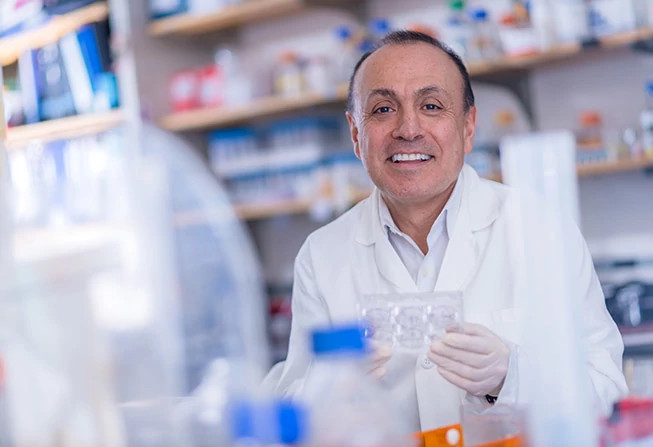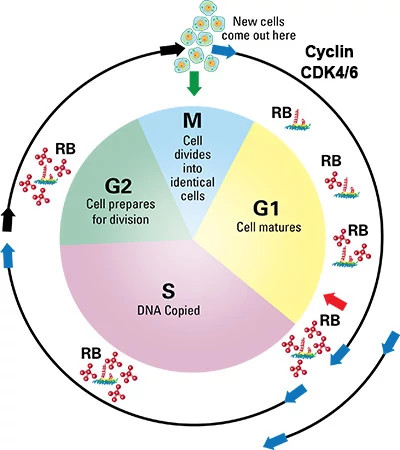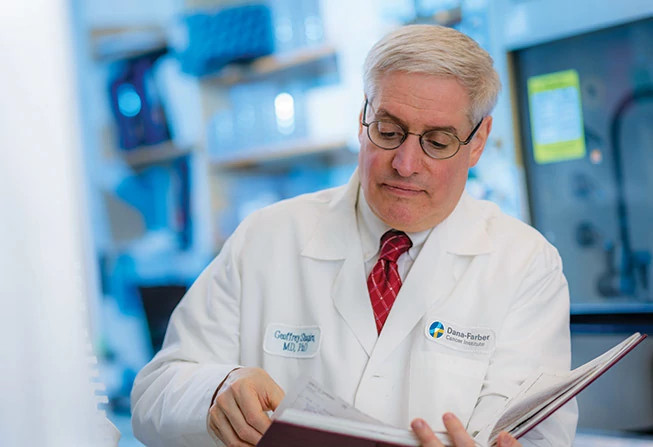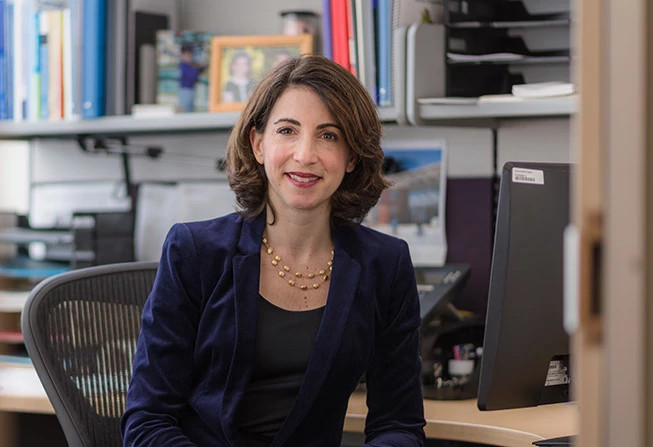Wrench in the Works
Stopping the Mechanism of Cell Division With New Drugs Known As CDK4/6 Inhibitors
By Robert Levy

When patients at Dana-Farber's Longwood campus in Boston are treated with drugs known as CDK4/6 inhibitors, they're about 30 years removed from the research that first revealed the promise of such drugs – and only about 30 yards from the laboratories where much of that research took place.
The story of CDK4/6 inhibitors – among the most broadly effective of all targeted therapies for cancer – was written to a large extent at Dana-Farber. It was Institute scientists who, in the late 1980s, helped identify the role of the cell proteins targeted by the drugs. It is Institute investigators who are leading a clinical trial of one such drug in almost 6,000 women around the world with a specific type of breast cancer. And it is Institute researchers who have shown in a group of highly influential studies over the past two years that the drugs may be even more powerful than originally suspected.
"CDK4/6 inhibitors have already been approved for patients with a particular type of breast cancer, in combination with hormone-blocking drugs – and if they perform well in clinical trials involving patients with other types of cancer, they have the potential to be one of the most widely used targeted therapies in our arsenal," says Dana-Farber's Peter Sicinski, MD, PhD, whose laboratory has been probing the drugs' targets since the late 1990s. "Dana-Farber is one of the rare institutions with the expertise to carry research from the stage of investigating cells' most basic machinery to converting that knowledge into potential drugs and then testing them in patients. CDK4/6 inhibitors exemplify the power of that approach."
The best place to pick up the trail that led to the development of CDK4/6 inhibitors is with a quick description of the cell cycle – the series of events that take place as a cell prepares for, and then undertakes, division.
Learning Division
A typical human cell takes about 24 hours to divide, although the rate varies depending on what type of cell it is (a liver cell, for example, divides only once a year). The process involves a vast, interlocking choreography of dozens of proteins and other substances acting and interacting in response to a chorus of cues.
The cycle is a drama in four acts, or phases, including intermissions in which the cell conducts a series of quality-control checks to make sure all is in order before beginning the next phase. One of the best organisms for studying the process is yeast, because the phases are easily discernible as yeast cells form buds that become new cells. It was in yeast that researchers in the 1970s discovered proteins called cyclins, which help push the cycle past the speed bump that separates one phase, called G1, in which cells grow in size, from the S phase, in which cells copy their DNA.
By the late 1980s, research into this aspect of cell division had become particularly intense. At the Dana-Farber laboratory of David Livingston, MD, scientists were working out the basic mechanics of the transition from G1 to the S phase – as were many other labs, including that of Ed Harlow, PhD, at Massachusetts General Hospital. The focus of much of their interest was a protein called pRb, also known as the retinoblastoma protein.
Livingston and his associates, including lab members James DeCaprio, MD, and William Kaelin, MD, discovered pRb to be a born obstructionist: Its job is to pause cell division at the end of the G1 phase so the cell can check itself for errors. As G1 proceeds, pRb is gradually induced to release its hold on cell division by a process called phosphorylation, in which compounds called phosphoryl groups are attached to pRb. The agent that affixes the phosphoryl groups is itself a stuck-together entity: a "D-type" cyclin paired with an enzyme called cyclin-dependent kinase 4 (CDK4) or its cousin CDK6. Matthew Meyerson, MD, PhD, a member of Harlow's lab who would join Dana-Farber a few years later and is now the Institute's director of Cancer Genomics, was the first to clone CDK6 so it could be studied by scientists, and showed it works in concert with a D-type cyclin.
It didn't take researchers long to see the implications of these discoveries. Cancer is, at its core, a disease of runaway cell division. CDK4 and CDK6 (together known as CDK4/6) provide a necessary impetus for cell division: without them, phosphorylation of pRb won't take place, and without that, cell division will freeze like a clock with a jammed pendulum.
As Livingston, now deputy director of the Dana-Farber/Harvard Cancer Center, says, "Under normal conditions, cells don't divide until they get an 'oomph' from CDK4 and 6 to move out of G1 phase. Drugs capable of blocking these kinases could, in theory, help arrest the uncontrolled division of cancer cells."
The rationale for pursuing such drugs became even stronger in the following years. Molecular studies revealed that one of the D-type cyclins, called cyclin D1, is overactive in many forms of cancer (actually, in most cancer types, researchers would later discover). There are a variety of ways this can happen, but one of the most intriguing from scientists' point of view has to do with CDK4 or 6. If either one is overabundant within a cell, it can combine with cyclin D1 to rev up pRb phosphorylation and accelerate cell division. The outsize influence of CDK4 and 6 on cell division seemed to make them ideal candidates as drug targets.
Within the scientific community, however, there were serious reservations about the practicality of CDK4/6-inhibiting drugs. "The dogma in the field was that the D-type cyclins, along with CDK4/6, were absolutely essential for the proliferation of normal cells," Sicinski relates. "A drug that blocked cyclins or CDK4/6 could, therefore, wreak havoc with division in every cell in the body. Such a drug would obviously be too toxic to take."

Sicinski and his colleagues decided to test whether this view was valid. They engineered several strains of mice, each of which lacked a specific D-type cyclin, and found, contrary to prevailing dogma, that the animals developed normally. When skeptics argued that the animals' remaining D-type cyclins had simply taken over the job of the missing one, Sicinski's team created mice lacking all three D-type cyclins and found that they, too, developed normally in their early stages.
The case for CDK4/6 inhibitors was strengthened when Sicinski's team showed that while cyclin D1 isn't necessary for normal cell development, it is needed for the development of certain types of breast cancer. And lastly, they showed that in adult mice with breast cancer, shutting down cyclin D1 caused the tumors to stop growing. (These results might lead one to ask why researchers sought to develop drugs targeting CDK4 and 6, rather than cyclin D1. The reason, Sicinski explains, is that the chemical structures of CDK4 and 6 are easier to block with drug molecules. Since CDK4/6 and cyclin D1 work in tandem, blocking either of them would have an anti-cancer effect.)
Getting Specific
The work of Sicinski's group and others convinced pharmaceutical firms to begin developing molecules that could throttle CDK4 or 6, or both. One potential drug, palbociclib, kept cancers in check in early clinical trials, but its manufacturer, Pfizer, was considering shelving it in favor of other agents.
"We thought the drug had potential, so with Pfizer's support we launched a trial in patients with mantle cell lymphoma, a cancer in which the gene for cyclin D1 is rearranged and overexpressed," says Geoffrey Shapiro, MD, PhD, director of Dana-Farber's Early Drug Development Center. "We did an analysis, including PET scans that measure the cell cycle, in tumor samples from patients both before and during treatment and demonstrated the drug actually hit its target."

The study, published in 2012 in the journal Blood, would prove to be the seminal paper in palbociclib's journey from promising compound to approved drug. "We showed that pRb phosphorylation was reduced in tumor cells that had been arrested in the G1 phase," Shapiro remarks. "This resulted in responses and long-term benefit in nearly 30% of participants, including some who had previously been treated with multiple chemotherapies or a stem cell transplant."
Research at UCLA spawned clinical trials of palbociclib in patients with metastatic, ER-positive, HER2-negative breast cancer, the most common breast cancer subtype, where the drug proved especially effective. Those trials and others led to FDA approval of palbociclib with hormone-blocking therapy and transformed the standard treatment for patients with this type of breast cancer. Shapiro also co-led the first studies of two other CDK4/6 inhibitors – abemaciclib and ribociclib – showing that they, too, hit their intended molecular targets. Both drugs have now received FDA approval for the same category of patients as palbociclib. Together, the three drugs have demonstrated that combining CDK4/6 inhibition with hormonal treatment is substantially superior to hormonal treatment alone.
Approval of the drugs to treat this form of breast cancer has galvanized researchers to explore whether CDK4/6 inhibitors can be effective at other stages of breast cancer treatment and in other types of cancer. Dozens of clinical trials of the drugs are currently underway in non-small cell lung cancer, mantle cell lymphoma, melanoma, glioblastoma, pancreatic cancer, colorectal cancer, and other malignancies.
When UCLA researchers reported their findings in breast cancer patients in 2012, Erica Mayer, MD, MPH, and Harold Burstein, MD, PhD, both from Dana-Farber's Susan F. Smith Center for Women's Cancers, were quick to perceive palbociclib's potential. "We want to offer our patients medicines that are highly effective but also have minimal side effects," Mayer remarks. "Work with palbociclib in metastatic breast cancer has highlighted its optimal balance of efficacy and tolerability, which has led to clinical trials of the drug in patients with earlier stages of breast cancer." She and Burstein launched a pilot study of palbociclib in a small group of these patients, finding it both safe and feasible to administer.

Today, Mayer is heading up one of the largest trials of palbociclib to date. Dubbed the "PALLAS" trial, it has enrolled almost 6,000 patients from 21 countries to evaluate whether the addition of palbociclib to standard hormonal therapy can lower the risk of recurrence in patients treated for earlier-stage ER-positive/HER2-negative breast cancer.
Susan F. Smith Center investigators are currently leading or participating in an array of trials involving CDK4/6 inhibitors. These include the "PELOPS" trial of palbociclib and hormonal therapy prior to breast cancer surgery, and the "PATINA" trial for patients with HER2-positive breast cancer led by Otto Metzger Filho, MD.
Finding Serendipity
Palbociclib and its sister drugs were originally conceived as agents that could put cancer cells in a state of suspended animation – alive, but not dividing, and therefore less of a threat. Recent studies by Dana-Farber scientists suggest the drugs may be even better cancer-stoppers than anticipated.
In 2017, Peter Sicinski's laboratory published a study suggesting that in tumors with high amounts of a certain protein complex, palbociclib not only prompts cancer cells to stop dividing but can also cause them to die. Within a few months, three groups of Dana-Farber scientists published papers showing that CDK4/6 inhibitors can spur the immune system to attack and kill cancer cells. When the drugs were coupled with immunotherapy agents, the anti-cancer effect can be even greater. These findings were the impetus for the "PACE" trial led by Erica Mayer, which is exploring the combination of palbociclib and immunotherapy in patients with metastatic breast cancer.
As CDK4/6 inhibitors have gained a place in standard therapy, Dana-Farber scientists are already working on ways to improve them. As part of his Metastatic Breast Cancer Project, Nikhil Wagle, MD, is collecting tissue from patients to understand why patients eventually become resistant to the drugs. Part of the answer, Wagle and Shapiro's teams found in a recent study, is that breast cancer cells sometimes gain the ability to overproduce CDK6, countering the effect of the drugs. And chemical biologists Nathanael Gray, PhD, Baishan Jiang, PhD, and Eric Wang, PhD, recently demonstrated a way to selectively degrade and destroy CDK6, which may help researchers tease apart the separate roles of these two enzymes, reverse the process of resistance, and potentially develop more precise drugs.
"The thread that connects some of the earliest research in CDK4 and 6 to the latest work in CDK4/6 inhibitors runs directly through Dana-Farber," Geoffrey Shapiro remarks. "The research that originally showed the potential of these drugs is today being complemented by work to make them more effective and extend their benefits to more patients."
Other Feature Stories from Paths of Progress 2019
-
Natural Killer Cells
Natural killer cells are the first wave of defenders against infection, and they may have a new role in treating cancer.
-
Cancer, Interrupted
Uncovering new strategies for identifying signs of pre-cancer – and stopping it before it starts.
-
Compound Growth
Chemical biologists create small molecules to boost discoveries and prototype novel therapies.
To see the entire publication, please download the PDF version.
Request a Publication
Receive by mail the current issue of a Dana-Farber publication by completing this request form.
Media Contacts
If you are a journalist and have a question about any of our stories or need more information, email media@dfci.harvard.edu or call 617-632-4090 and ask to speak to a member of the media team.
The Media Team cannot respond to patient inquiries. For more information on contacting Dana-Farber, please see Contact Us.
Disclosure of Advisory Roles and Certain Industry Support
See an overview of relevant board memberships, outside support, and significant advisory roles as reported by several physicians and researchers featured in the 2019 issue of Dana-Farber's Paths of Progress magazine.